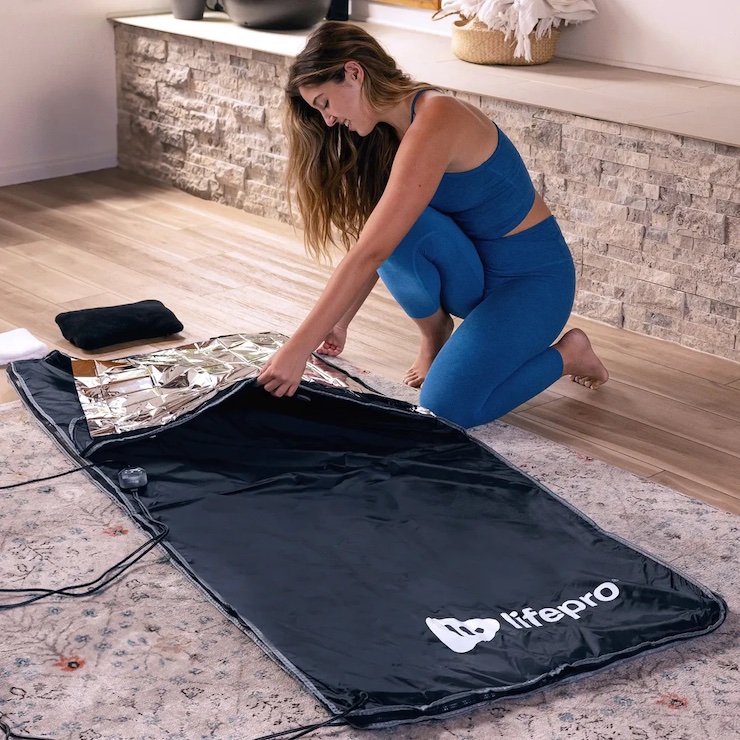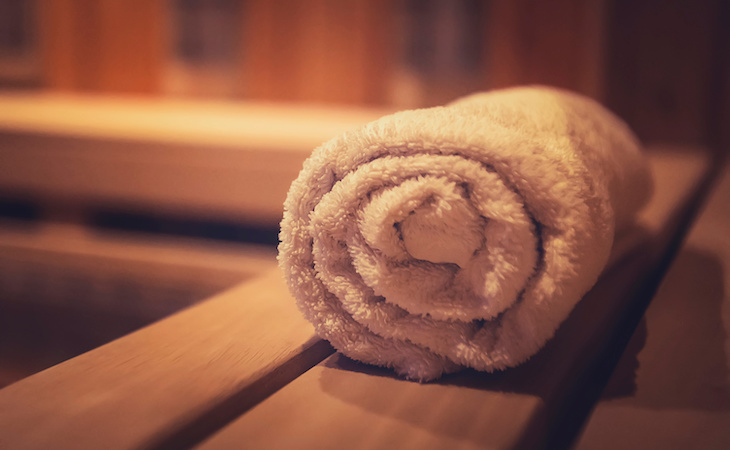As someone who chronically struggles with sleep—and more specifically falling asleep—I’m always on the lookout for wellness trends that could help me get better Z’s. As someone who’s also chronically cold, I recently discovered a sleep hygiene trend that I was eager to try—and that’s sauna blankets.
I’ve long been aware of the sleep-boosting benefits of regularly using a sauna (for example, in one study, a whopping 83.5% of people reported sleep benefits after regular sauna use)—so I was curious whether the at-home version would produce the same results.
After a month of using the sauna blanket a few times a week, I can confidently say that—at least for me—a sauna blanket has been a worthy addition to my pre-bedtime routine.
Let’s take a look at all things sauna blankets: what they are, potential sauna blanket benefits (and potential disadvantages), and my personal experience with spending time in a sauna blanket—and how that time ultimately impacted my sleep.
What is a sauna blanket?
First things first. Before we jump into how sauna blankets can impact sleep, let’s quickly touch on what, exactly, a sauna blanket is.
A sauna blanket is…well, exactly what it sounds like. It’s a blanket (shaped more like a sleeping bag) made out of heat-resistant materials that recreates the effects of a sauna.
Sauna blankets use infrared light to increase body temperature and induce some serious sweating (just like a sauna)—but instead of having to go to a physical sauna, you can use it in the comfort of your home (for example, on your floor or bed).
A sauna blanket is a blanket shaped like a sleeping bag made out of heat-resistant materials that recreate the effects of a sauna. Sauna blankets use infrared light to increase body temperature and induce some serious sweating—but instead of having to go to a physical sauna, you can use it in the comfort of your home.
You can invest in a sauna insert (which is similar to a towel) to prevent sweat from getting on the actual sauna blanket. Many sauna blankets also come equipped with thermal foil inserts to help increase heat retention, induce more sweating, and provide better results.
While different models work differently, with most sauna blankets, you choose a temperature that you’d like (my sauna blanket offers temperatures between 113 and 176 degrees Fahrenheit), set a time frame, and then you’re ready to get in the blanket and go.

Infrared sauna blanket benefits and disadvantages
Now that you know what a sauna blanket is, let’s jump into infrared sauna blanket benefits.
Spending time in a sauna offers a variety of benefits, including:
- Feel-good hormones. Spending time in a sauna can have an impact on hormones, helping to induce “the release of dopamine, endorphins, and serotonin,” says Raleigh Duncan, a doctor of chiropractic and founder and CEO of Clearlight, a company that offers infrared saunas and other health and wellness solutions. This can help improve mood and increase relaxation.
- Decreased stress. Studies suggest that saunas may lower cortisol (also known as “the stress hormone”), which can help people feel more relaxed and less stressed.
- Improved immune function. Research also suggests that spending time in a sauna can help improve immune function. For example, this study found that spending time in a sauna—and the following cool-down period—stimulated participants’ immune systems and boosted white blood cell counts. Sauna blankets “boost immune function by raising core temperature,” says Duncan.
- Improved cardiovascular health. Research also shows that spending time in the sauna decreases the risk of cardiovascular death. That lowered risk is correlated to frequency—so the more frequently you use the sauna, the lower your risk of death from cardiovascular issues.
- Detoxification. Sauna blankets make you sweat—and that sweating can act as a detoxifying process for the body. “[Spending time in a sauna blanket] removes toxins from the body through sweating,” says Duncan.
Sauna blankets also offer a number of benefits that are directly correlated to sleep (more on that in a moment).
But while sauna blankets can clearly offer benefits, there are some drawbacks—including price.
While there are some affordable sauna blanket options out there (I got mine for about $170), other options are on the pricier side, ranging from about $350-$700 dollars—which is definitely cheaper than installing a sauna but isn’t exactly budget-friendly.
Sauna blankets also aren’t the right fit for everyone. People who have certain medical conditions—for example, cardiovascular issues, blood pressure issues, pregnancy, or a history of seizures—should absolutely consult a doctor before incorporating a sauna blanket into their routine.
Is a sauna blanket good for sleep?
Now, for the million-dollar question—are sauna blankets good for sleep? In my experience? Yes.
As mentioned, over the past month, I’ve been using my sauna blanket a few times a week. While it took me a few tries to land on the right time and temperature, I ultimately figured out that 30 minutes at 140 to 150 degrees Fahrenheit was my personal “sweet spot.” Using the sauna blanket at that duration and temperature definitely felt like it gave me the sleep-inducing boost I was looking for.
That came down to a few things. First, once I settled into the sauna blanket experience, I felt really relaxed—really quickly.
“Sauna blankets can take you from fight or flight (sympathetic tone) to the relaxed state (parasympathetic tone),” says Duncan. “Stress melts away along with muscular tension and pain.”
I also found that the level of relaxation I experienced was correlated to what I did in the sauna blanket. When I watched TV, the experience felt less relaxing—but when I paired it with an activity that allowed me to close my eyes (like listening to music, tuning into a podcast, or doing a meditation or breathing exercise), I was able to fully relax, unwind, and sink into my body.
And while I never fell asleep while using the sauna blanket, spending time in the sauna blanket the hour or so before bed put me in a state that made it easier to fall asleep once my head hit the pillow—which is my biggest sleep-related challenge.
One reason why the sauna blanket helped me drift into sleep more easily? It may help boost melatonin—a hormone associated with sleep. “The heat from the sauna helps to release melatonin, which signals the body to sleep,” says Duncan.
There’s also research to suggest that spending time in a sauna (which, again, a sauna blanket mimics) can support better sleep in other ways, including reducing pain (which, as someone who lives with rheumatoid arthritis, is a major plus) and increasing core body temperature—which can help you get better sleep thanks to the temperature drop that follows in the post-sauna cool down (as body temperature needs to drop for sleep).
If you’re thinking about incorporating a sauna blanket into your sleep hygiene routine, here are some tips to keep in mind:
- Use the sauna blanket at the same time each night. If you want to maximize the benefits of your sauna blanket, use it at the same time (on the nights you use it). “Use the sauna at the same time before sleep for at least four times per week,” says Duncan. “This helps imbed the biological sauna effects into your circadian pattern, making them more potent over time.”
- Take a hot shower immediately after. One of the goals of the sauna blanket is to make you sweat. But most people don’t want to go to sleep sweaty—so jump into a hot shower to rinse off immediately after your session.
- Give yourself time to cool down before attempting to go to sleep. After your session (and your hot shower, if you choose to take one), it’s important to give yourself some time to cool down before you go to bed. “Have a 30-minute cool-down period after the sauna session,” says Duncan. “This will increase production of melatonin in the body for deeper sleep.”
How to use a sauna blanket safely
Another thing to keep in mind if you’re planning to try an infrared sauna blanket for better sleep? Safety.
Some safety tips to consider include:
- Hydrate. You’ll sweat in the sauna blanket—and the more you sweat, the higher the risk of dehydration. That’s why it’s important to “drink plenty of water before, during, and after sessions,” says Duncan. Sauna use can also cause a loss of electrolytes—so you may also want to consider having an electrolyte-replenishing beverage, like a sports drink, after your sauna blanket session.
- Start small. As mentioned, it took me a while to find the right temperature and duration for my sauna blanket sessions. If you want to take the safest approach to finding yours, then it’s best to start small. “Always be conservative in length of time and temperature when using a sauna blanket,” says Duncan. “Always build up higher heat and longer times over days and weeks of usage.”
- Listen to your body. Sauna blankets aren’t for everyone—which is why it’s important to listen to your body. If, at any time, you experience adverse effects during or after a sauna blanket session (for example, dizziness or nausea), then stop using the sauna blanket and consult your doctor.
- Set a timer. Many sauna blankets come equipped with an auto-timer—which will automatically shut off the blanket at the end of the programmed session. But if yours doesn’t, make sure to set a timer so you don’t spend more time in the sauna blanket than you planned.
- Consult your doctor. As mentioned, sauna blankets may not be the right fit for people with certain medical conditions—so if you have any health issues, then make sure to consult with your doctor before trying a sauna blanket.
FAQs
Are sauna blankets good for you?
It depends! While sauna blankets may offer a variety of health benefits, they’re not the right fit for everyone. If you’re unsure whether a sauna blanket would be helpful in improving your sleep, talk to your doctor.
How often should you use a sauna blanket?
Ideally, sauna blankets should be used a few times per week. “The sweet spot for maximum sauna effectiveness is four times a week for at least 20 minutes per session,” says Duncan.
Can taking an ice bath help you sleep better? Check out our review of cold therapy for sleep.





